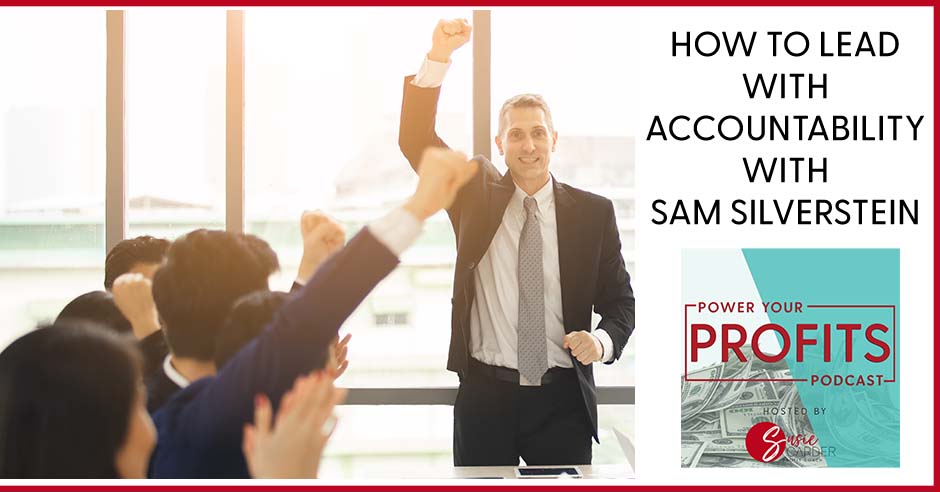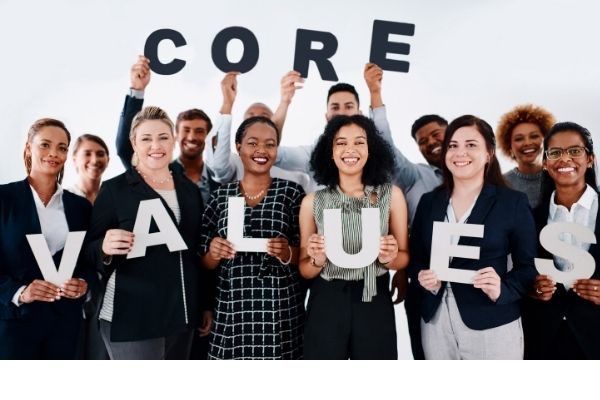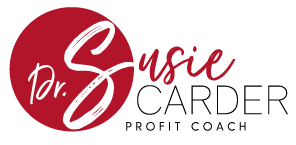
Accountability is a term we hear so much about in relation to leadership. However, many people don’t really understand what it means, especially when it matters most. Today’s guest is here to clear this up. Sam Silverstein is a speaker, author, entrepreneur, accountability, culture expert, and founder of the Accountability Institute. He has authored many books on the topic, such as I Am Accountable, Non-Negotiable, No More Excuses, Making Accountable Decisions, and No Matter What. In this episode, he sits down with host Susie Carder to define accountability and how it should look in a healthy organizational culture. Join in on the conversation for a new take and a deeper understanding of leadership.
—
Watch the episoode here
Listen to the podcast here
How To Lead With Accountability With Sam Silverstein
My next guest is Sam Silverstein, a speaker, author, entrepreneur, and Founder of The Accountability Institute and the Certified Accountability Advisors. He is the author of eleven books, including I Am Accountable, Non-Negotiable, No More Excuses, Making Accountable Decisions, and No Matter What. Sam has been inducted into the Speaker Hall of Fame. Please welcome my guest, Sam.
—
Welcome to another amazing episode. I have a super exciting person to introduce you to, Sam Silverstone. He owns and is the Founder of The Accountability Institute. You did $100 million in sales in your career time, which is pretty juicy. He’s the author of eleven books all around accountability, Non-Negotiable, No More Excuses, Making Accountable Decisions and No Matter What. He is included in the Speaker Hall of Fame. Welcome.
It’s great to be here, Susie. Thank you for all that. The first thing you have to know is I had a team of people that helped make that $100 million in total sales that happened. It was not just on my shoulders.
Tell everybody what your magic is and what are you doing to serve our market?
My purpose is to help people discover their potential and be the best they can possibly be. My magic is that I listen to the message that’s given to me for the purpose of being the steward in sharing. What we’ve discovered is accountability is at the very foundation, and we have a unique take on it, and the ability to teach others how to understand it. That’s where our magic is.
One of my coaches said to me, “Susie, you honor the dignity of the human spirit when you hold people accountable. Quit being a chicken.” I used to feel like I had to be the bad guy, or you get my dukes up like, “I’ve got to go in. I’ve got to hold them accountable.”

That’s the whole thing, Susie. It’s not about holding people accountable. We have a misconception. Accountability is not a way of doing. It’s a way of thinking and how we think about people. When people aren’t doing things, that’s a neglect of responsibility and not accountability. The reason we struggle with accountability is because for the most part, what I’ve discovered in all of our research, people don’t understand what it really is.
You talk about the difference between accountability and responsibility are completely different. Watching that, I’m like, “I lump them together too.” Accountability and responsibility, you lump them in the same thing. Talk about from your standpoint of doing this for years. Sam and I were seasoned. We’re spicy but we’re seasoned.
Everything we’ve been taught about accountability is wrong because accountability is not a way of doing but a way of thinking and how we think about people. Accountability isn’t leadership trying to manipulate people to do more for them. Accountability is leadership being accountable first to the people.
In doing so, it creates an environment and a workplace culture that inspires people to want to be their best and to choose to be accountable. Once leaders see their people differently, treat and commit to them differently, they get a different result. Accountability is simply stated as, “Keeping our commitments to people.” There are tactical and relational commitments. We can go there if you want but it’s all about the relational commitments. We define a commitment as, “No matter what.” When leaders keep a relational commitment to people, what happens is they inspire their people to the point that they would rather die than let that leader down.
You also talked about accountability as the foundation of our businesses. People think of it as an afterthought. It’s like, “I’ve got to have accountability. I’ve got to have them be responsible.” Talk a little bit more about that because that’s a delicious distinction.
You’re responsible for things but you’re accountable to people. That report is not going to hold you accountable. As leaders, we should be helping our people be accountable because nobody wants to be held accountable. Holding someone accountable is like putting a gun to their head. Nobody wants that. How do we help people be accountable? We help them by being there for them first by modeling accountability, and we do that through these relational commitments. One of the key ones is a commitment to the values. In any organization, there is a culture. This is where all the magic happens.
You’re responsible for things but you’re accountable to people.
That culture is either a culture by design or by default. If it’s a culture by design, then it’s been defined through the values. That’s where all these pieces come together. Is there an amazing set of values through its totality? Does it have foundational values, which talk to the organization’s character? Does it have relational values, which explain how relationships work both internally and externally, and professional values? What is excellence here in this organization? Community values. How do we connect to and serve the community in which we’re doing business? When you have a set of values that in their totality connect to all four areas, you have a set of values that will define a culture that can be amazing.
I’ve never seen people make connections. Your creative is your value, your innovation is your integrity, and your change is your accountability. People use those sexy words but we’re putting more meat on the bones when you frame it that way. Do you want to share? It’s because it’s a little different than what other leaders are doing inside of accountability.
What happens is when you’ve created this amazing set of values, you have values that talk about how our relationships internally, for instance. You can never have a better relationship with a client than you can have inside the organization. If customer service is not where it should be, or when a leader or one of our certified accountability advisors calls us to come in and help them with accountability, we know there’s a relationship problem in the organization.
You define your values. You have values that talk about character, integrity, relationships and professionalism. What’s the level of excellence that’s here and the community values? The question is, “Does the leader model live and teach those values? Are those values in play? Do you allow someone to stay in the organization who’s great in sales but is terrible at relationships?”
If you allow me to stay in the company because I’m the number one salesperson but meanwhile, I’m ticking off three people because I disrespect them, then the value of respect isn’t the value here. The hard part is where it’s committing to the values and not allowing someone to stay who doesn’t live the values because then you go from a culture by design to culture by default, which means anything goes.
We always say, “The tongue in your mouth and your tongue in your shoe, are they going in the same direction or different directions?” It’s like, “Do as I say, not as I do as your parents or as kids,” and you’re like, “What does that mean?” There are many people like, “Leadership and accountability is theory. It works for you but not for me.” It’s hard to follow a leader inside that. Many of that chaos, and you get that disruption. It’s not fun.

When a leader says, “Do as I say, not as I do,” they have no integrity because, “I’m supposed to live to this standard, but you don’t have to.” As an employee, I have no respect for that leader. If I have no respect for that leader, there’s no accountability on her part as a leader or my part because you’ll never be accountable to someone you don’t like and respect. It’s torn down. It’s like the leader that says, “I have 32 headaches and each one has the first name.”
This is how they see their people or the leader looks at you and says, “As they’re changing their compensation plan, their commission plan or wherever they go, ‘This isn’t personal. This is business.’” That’s a pile of crap. Every interaction between two people is personal, so the leader that goes down that road doesn’t get it. Accountability comes down to valuing people because if you, as the leader, value people and your actions align with your words, like you said, “The tongue in your shoe lines up with the tongue in your mouth,” they want to work harder. They’re committed, want to do a great job, and see the organization and you as the leader succeed. It always starts with the leader being accountable and valuing people first.
What I love most is you take this natural, knowing that people naturally do it, but they can’t distinguish why they do it. That was me building my first million-dollar business. It was like, “How did I do it so I can give that to my students,” versus, “I just did it.” When you dissect it, accountability or responsibility can seem so fluffy. It’s not. It’s the backbone of a business. I’ve always had amazing people because I treat them as amazing people. I see them as their possibility and not their human behavior.
That’s 1 of the 10 relational commitments that we’ve discovered and defined, which is seeing the potential in your people and leading them to that potential so they can be their best. That is a relational commitment. When you treat your people like that, and I’m saying this for everyone, that’s reading, who doesn’t want to work for someone who’s always looking for their potential, positioning them to be their best, getting them extra training, and putting them in places where they can shine? I don’t want a boss. I want a leader and a mentor looking out for me. When I know you’re committed to me, you better believe I’m all-in committed to the organization through you.
Let’s talk about building $100 million in sales, and that’s over your career. We’ve had some big breakdowns, so I always say, “The bigger you play, the bigger the breakdown.” Some people call it a failure, obstacle, challenge, or whatever sexy name we want to give it. What has been one of your biggest failures that you’ve experienced, and what did you learn?
In business, what happens is a lot of experts speak from their mountaintop, “Let me just share all the good,” which is great. We learned from that too. I learned as a business owner when I’m on my knees, when I have been humbled and when I have to go, “What is the lesson?” What would you say one of those biggest learning experiences has been for you?
Value your people because you work hard to hire good people. All you have to do as a leader, owner and entrepreneur is take care of your people.
I had an organization with about 175 people at one point in time. The attitude among myself and the partners was that we had the answers, meaning the executives and owners. All you had to do was execute. That’s backward. It’s wrong. It’s not true. I was young and cocky. I thought I had it all figured out, but I didn’t. It’s not that I was dumb, stupid or didn’t have many answers, but the reality is that people doing the job have the answers. They’re closer to the job.
Our organization had a manufacturing organization. We had gone from being highly profitable to being highly not profitable, which is that on your knees position you’re talking about. We were hemorrhaging money. Everything I had, building, piece of inventory, equipment, and my home was on the line guaranteeing debt growing at an incredible rate. Finally, we had a meeting. In this meeting, I realized if I didn’t turn this over to the people to solve, it wouldn’t get solved because they were the ones that were hands-on with the projects and had to deliver.
We were delivering a product in 6 to 8 weeks. It needed to be in two weeks, and the quality was terrible. It’s a high-quality design but low-quality execution. I asked the gentleman who was in charge of production. I said, “How long does it take to make a window?” He said, “A week.” I said, “Can you make a window in a week?” “Yes.” “You’re saying that if you have orders in by Friday noon, they could be done the following Friday noon?” “Yes.” My partner’s going, “We need them in two weeks.”
I’m like, “If you make them in two weeks, that means the orders were sitting here for a week, and then you make them in a week. If you can make them in a week, we can blow our customers away with customer service. They’ll go nuts. Figure it out, let me know what you need and make it happen.” That was it. When we turned it over to him and his team of people, which were all the frontline people, everything changed.
Within six weeks, we were shipping products like crazy. By the end of 90 days, our profitability had totally reversed, and we started making money hand over fist. The problem was I didn’t trust the people, and the solution simply was to value the people because you work hard to hire good people, value them, put it in their hands, and let them take care of the business. All I have to do as a leader, owner and entrepreneur is to take care of my people.
That’s an anomaly in the workplace. I have team members that when they come to me, they’re like, “I don’t know.” I’m like, “I’m sorry. I don’t know it doesn’t work here. That’s a five-year-old answer to a question. You’re smart or you would not have been put in this role.” It’s empowering them to learn how to use their voice because many corporations and entrepreneurs don’t allow them to use their voice so they refer back to you like, “What do you think, Sam?” “That’s not my job. I’m hiring you because you are the expert in this. I’m the expert in this, and I’m not the expert in that.”
Even my admin assistant is like, “If you tell me ‘I don’t know’ one more time, it’s not going to work. I don’t need someone who doesn’t know. If I have to tell you how to do your job, one of us is not needed. You choose.” Harsh but loving, “I love you. Use your brain. You’re smart.” We, as leaders, make people so weak by giving them the ‘it’ or the answer.

I see this all the time, where a lot of our clients are using our development tools and have an amazing culture. There’s a merger acquisition, and they take on another organization. They bring in these employees from the other organization and are used to a different culture. When they come into this culture where people are empowered and have a voice, if you have an idea, it doesn’t matter. Whether you’re the janitor, VP of Sales or merchandising, the leadership wants to hear it.
When people come into an organization like that, some of them are able to make the leap and adapt, but others can’t and have to go by the wayside. That’s because they’ve been trained by poor cultures, which have been created by poor leaders that you don’t have a voice. Why do you want to hire someone and not get all of them, which means their most valuable asset, their brain?
They don’t have accountability. When I took over Lisa Nichols’ company, there was never accountability. They were all like, “She’s mean. She’s scary.” I’m like, “I want a weekly report. I want to know what we’re paying you for.” There is an adjustment. I don’t know if you’re experiencing this with your client, but a lot of businesses with this pandemic and the global upset, I find that people are struggling and still waiting, which I don’t know why they’re waiting. I’m like, “There is no wait. This is a new realm of business.” What are you seeing with your students and what’s the secret sauce to keeping them in action and growing?
There are lots of businesses and companies that are thriving out there. First of all, I don’t think that the rules of being successful have changed. Sometimes, the grass is a little taller and you can’t run as fast. Sometimes, the grass is cut shorter and you can run a little faster. What works is always going to work, which means, are you contacting people? Are you building relationships? Are you offering value or service that’s needed? Are you trying to sell what you do or are you trying to understand your clients and their needs are and then be there to serve their needs? That’s what value is.
It’s not selling your product. It’s understanding their needs and then solving a problem for them. It remains the same. The organizations that I have seen that have thrived during pandemic times are the ones that had taken the time to create and design a strong culture before it happened. They know what their values are and are very specific about their purpose and mission. Everyone in the organization knows how they serve that mission. They’re aligned and efficient with their time because they’re working on the mission. We’ve seen during the pandemic that the leader has the acuity to realize that her or his people have different needs in this time.
The leaders serve their people differently, so their people can serve the clients differently. For example, one of our clients, the managing partner said, “It’s business as usual. We’re going to work from home.” I said, “You’re only half right. You’re working from home. It’s not business as usual because when your people go home in this environment, they’ve got kids, parents and spouses at home. What are you doing to create an environment in your people’s homes so that they can take care of their needs and work efficiently for the organization? This is a new set of challenges that we need to face.”
Anyone can make money when times are good. The best organizations are the ones that will thrive during the bad times.
You need to be aware of what’s going on out there. The marketplace is ripe, people have needs, and organizations are trying to grow, which means they need products and services. The question becomes, “How does your expertise align with the needs of the clients that you already have, which is always a low-hanging fruit? What are you doing to find new clients and build new relationships because we always have to be looking for growth?”
We say that we lose 30% of our clients every year. If you look at that and you’re not replacing that, you’re out of business or stagnant. That’s why those businesses that never grow, you’re like, “What are you doing?” They’re not doing anything. That’s the problem, which is the status quo. A lot of businesses are sticking their head in the sand waiting and you’re like, “Get it out on the sand.” Wealth is built in these economies. This is where you will build your wealth if you can ride the wave, re-pivot your business and look at the change, innovation and creativity.
There are so many opportunities now. Now is the time to do it. Anyone can make money when times are good. The best organizations are the ones that will thrive during the bad times. They’re positioning themselves for this exponential growth coming out of these tough times. Leverage the opportunity that’s there.
Sam, what do you want to be remembered for? If there’s anything you could choose, what’s the Sam Silverstein, “I want to be remembered for this?”
Fifty years from now, somebody is reading one of my books or potentially going through the Certified Accountability Advisor Program that’s still in existence because we put something in place that has legs. I want to be remembered as someone who worked to create a more accountable world that helped people understand that individually and businesses be more accountable inside the organization. That’s what I want to be remembered for. That’s our mission, my mission and something we look at every day.
What’s one question you wish I would have asked to share with our community?

You asked a great question, Susie, and because of your experience, you know what matters. The one question, “What’s the first step that I should take as an entrepreneur or business person to building accountability individually or in my organization?” We’ve talked about this. It’s part A and part B. The first step is to understand and define in writing what your values are. We’ve created a tool to help, and it’s available at ValuesWorksheet.com. It’s free.
Understand what your values are. The B part is to commit to those values no matter what. They’re absolute. It’s non-negotiable that you are not going to make a decision that knowingly violates your values. You’re not going to allow someone to stay in your organization that repeatedly violates your values. If you do that, you’ll change the trajectory of your life, the people that work for you and ultimately your organization.
If you’re not managing from your values, it’s the value of convenience to own them. I’ve made hard business decisions because one of my highest values is integrity. When you need the money, you’re like, “It’s not in line with who we are. I’ve got to give the money back. I’ve got to end the contract. I don’t want to pursue it.” You hear it from me and from Sam with that emphatic-ness. You mentioned one freebie, the ValuesWorksheet.com, but you also have a juicy quiz we could take.
It’s CoachingBlindspot.com, which is for executive coaches and consultants. What’s the blind spot in your business that you might be missing and need help in taking your coaching and consulting business to the next level? It’s a 60-second experience and it gives you feedback right away and offers a masterclass on what we’ve talked about to take it deeper and show you how to apply it to your life.
We always tell our students that it doesn’t have to be hard. It has to be strategic. This is a strategic way of looking at accountability in your business as a system and not as, “I’ve got to be me. I’ve got to have another worksheet to go.” This is the foundation of the business. You said, “Accountability is the foundation of a business.”
I want to thank you for being here, for your generosity, for what you do in the world, and for empowering us to hold and support people in being accountable and responsible for the result they’re creating. If we have a team of people that are holding that flag with you, we can be change agents all over the world. Sam, thank you. I appreciate you. I’m excited for our community to get to know you. I never missed an opportunity to learn, so I appreciate you and thank you.
Important Links
- Accountability Institute
- I Am Accountable
- Non-Negotiable
- No More Excuses
- Making Accountable Decisions
- No Matter What
- https://www.Facebook.com/samuelsilverstein
- https://www.Facebook.com/MyPivotLife
- https://www.Instagram.com/samsilverstein/
- https://www.YouTube.com/c/SamSilverstein
- https://www.LinkedIn.com/in/samsilverstein
- ValuesWorksheet.com
- CoachingBlindspot.com
- www.SamSilverstein.com
About Sam Silverstein



